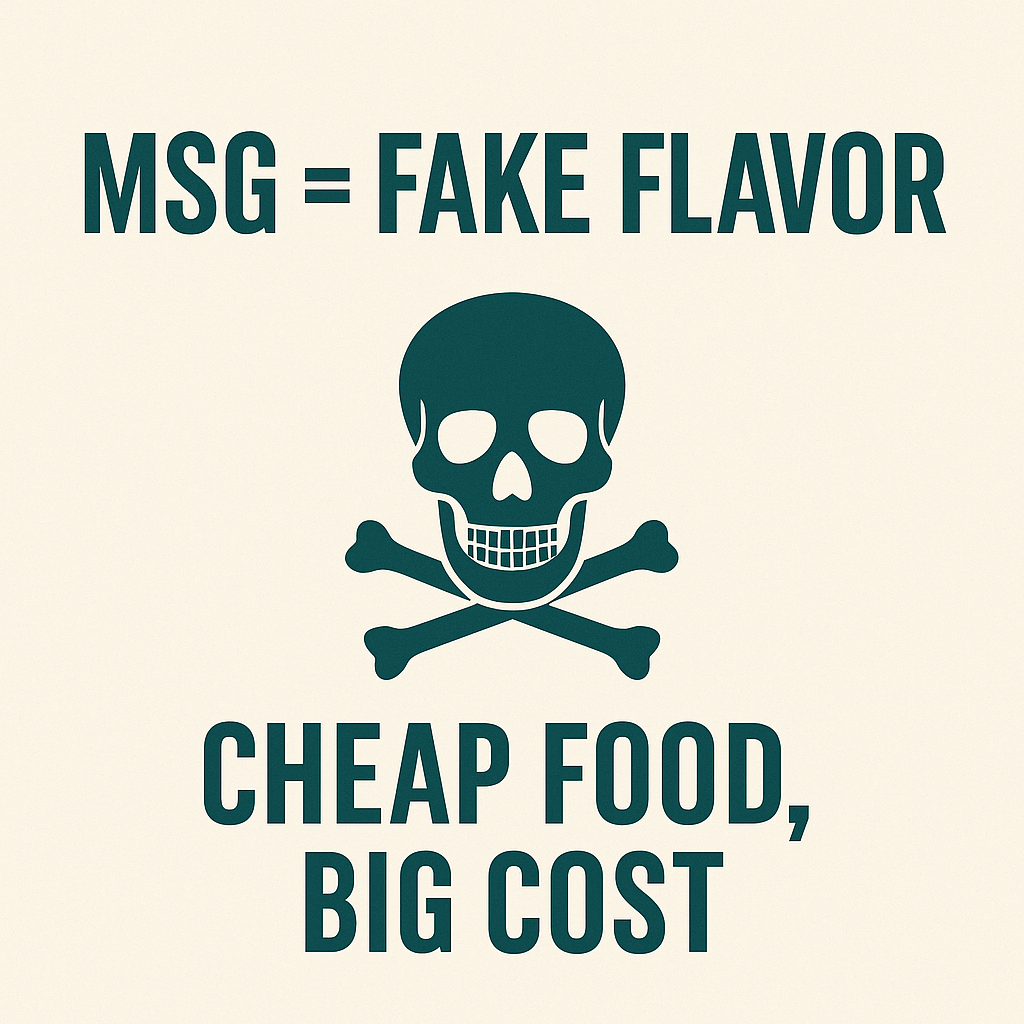
The Hidden Dangers of MSG: What’s Lurking in Your Pantry
Share
You’d be surprised how often food companies hide the truth in plain sight — and MSG (monosodium glutamate) is one of the worst offenders. It’s everywhere: ramen noodles, flavored chips, bouillon cubes, canned soups, frozen dinners, even “healthy” plant-based snacks.
But MSG isn’t just a seasoning. It’s a chemical trick that hijacks your brain and inflames your body — especially your gut.
What Exactly Is MSG?
MSG is a lab-made form of glutamate, an amino acid that occurs naturally in foods like tomatoes and mushrooms. The problem is that natural glutamate is balanced by the other nutrients in real food. The synthetic version — MSG — overstimulates your taste buds, making bland food taste addictive.
That’s why it’s so common in cheap, mass-produced products. It fools your body into thinking you’re eating something savory and satisfying when really, you’re just eating empty, chemical-laced calories.
MSG = Fake Flavor (and Cheap Food)
Let’s get one thing straight — MSG is the flavor of cheap.
When a company loads their product with MSG, what they’re really saying is:
“We used low-quality ingredients, and we need chemistry to make it taste like food.”
MSG gives the illusion of richness, but it’s just a cover-up. It hides blandness, poor quality, and the absence of real herbs, spices, and slow-cooked flavor.
- Real food — simmered broth, roasted vegetables, quality meat — has depth.
- Fake food — instant noodles, flavor packets, gas-station chips — has MSG.
MSG is the bandage on cheap cooking. It’s how manufacturers make corn starch and oil taste like dinner. The cheaper the product, the more likely you’ll find MSG or its disguises: “yeast extract,” “natural flavors,” or “hydrolyzed protein.”
Cheap = MSG. And the sooner people stop buying into that fake flavor, the faster the food industry will have to clean up its act.
Why MSG Is So Dangerous
MSG is what’s called an excitotoxin — it overstimulates your brain’s nerve cells until they literally burn out. This can trigger all kinds of symptoms:
- Headaches or that “Chinese restaurant syndrome” feeling
- Rapid heartbeat or heart palpitations
- Facial pressure or flushing
- Fatigue and brain fog
- Dizziness and vertigo
- Joint pain or swelling
- Anxiety and insomnia
For people with autoimmune issues or chemical sensitivities, MSG can make inflammation skyrocket. It disrupts gut balance, can trigger IBS-like symptoms, and messes with hormones. In kids, it can lead to irritability, stomach pain, and long-term gut trouble.
A Personal Note: When “Snack Time” Turned Dangerous
From Nana: Two of my grandchildren were living with their dad for a time, and Takis — yes, those fiery rolled chips — were a daily thing. Every time I talked to them, they were eating Takis. I told them to stop, warned about MSG, but the habit stuck.
Then the first one — just eight years old — got sick. Appendicitis. Rushed to the hospital, appendix removed. I was heartbroken.
A couple of months later, the second one — same story. Appendicitis. Another emergency surgery.
That’s not coincidence. That’s inflammation and toxicity showing up where it hurts most. Those daily MSG-filled snacks had been attacking their little systems from the inside out. They’re not allowed to eat MSG anymore. Period.
Sneaky Places MSG Hides
Food companies know people avoid MSG, so they disguise it under other names. Watch for these on labels:
- “Yeast extract”
- “Hydrolyzed protein” (soy, corn, wheat, etc.)
- “Autolyzed yeast”
- “Natural flavoring”
- “Sodium caseinate”
- “Textured protein”
- “Flavor enhancer E621”
And the foods that love to sneak it in:
- Flavored chips and snack mixes
- Instant ramen and cup noodles
- Bouillon cubes and soup bases
- Frozen dinners
- Salad dressings and dips
- Seasoning blends and “umami” mixes
- Canned soups and gravies
What MSG Does Over Time
Long-term MSG consumption triggers inflammation — and chronic inflammation is the foundation of obesity, diabetes, autoimmune flare-ups, and hormone disruption. It also interferes with leptin, the hormone that tells your brain you’re full. That’s why you can eat an entire bag of chips and still crave more — your brain’s signals are scrambled.
How to Avoid MSG
- Cook at home — control what goes in your food.
- Use herbs, garlic, and sea salt for flavor instead of seasoning packets.
- Make your own broths and soup bases instead of bouillon cubes.
- Read every label — if you can’t pronounce it, skip it.
- Choose clean-label or AIP-friendly foods where every ingredient is real.
Your body knows when it’s finally being nourished instead of tricked. Cut out MSG and watch the headaches ease, the brain fog lift, and the bloat disappear.